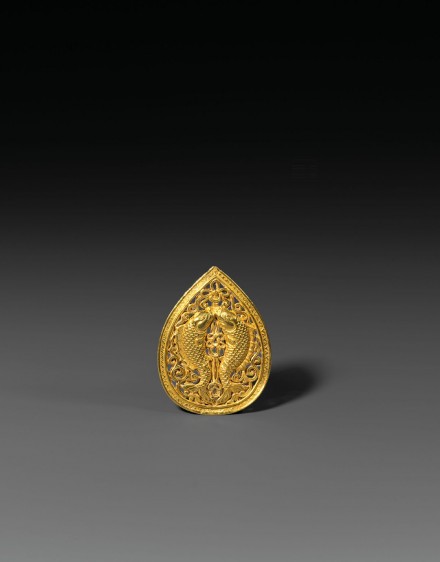J.J. Lally & Co., Oriental Art / New York City, New York
MenuPast Exhibition
Silver and Gold in Ancient China
March 16 – April 14, 2012

39.
AN OPENWORK GOLD ‘TWIN FISH’ PENDANT
Song Dynasty (A.D. 960-1279)
of flattened teardrop shape, decorated in rounded relief and openwork on both sides with a mirror-pair of confronted fish shown hanging from and festooned with long ribbons tied in ornamental knots and draped down both sides in elaborate symmetrically-arranged scrolls, all within a raised half-round border enclosed by a wide flat edge decorated with a running band of incised zig-zag and punched rings, the fish realistically detailed, with finely chased scales and fins, the uppermost knot of the ribbon surmounted by a central loop for suspension.
Length 3 inches (7.5 cm)
A gold pendant of similar form decorated in openwork with a phoenix and peony design, excavated in 1980 from a Northern Song tomb at Mufushan, Nanjing, and now in the collection of the Nanjing Museum, is illustrated in Zhongguo meishu fenlei quanji, gongyimeishu bian 10: jin yin boli falang qi (Compendium of Chinese Works of Art, Arts and Crafts 10: Gold, Silver, Glass, and Cloisonné), Beijing, 1987, p. 41, nos. 86 and 87, with description on p. 25, where the author states that this type of pendant was worn on a silk cord or necklace and used as a pomander.
Another very similar gold pendant, decorated with ‘twin ducks’ and lotus, in the collection of the Nanjing Museum, is illustrated in Zhongguo meishu fenlei quanji, Zhongguo jin yin boli falang qi quanji (Illustrated Classification of Chinese Art, Chinese Gold, Silver, Glass, and Cloisonné), Vol. III, Gold and Silver (III), Shijiazhuang, 2004, p. 18, no. 35, excavated at Wu county, Jiangsu province from the tomb of Lu Shimeng, dated by epitaph to A.D. 1304.
A Song dynasty openwork gold ‘twin phoenix’ pendant of similar form with very similar borders is illustrated in Chinesisches Gold und Silber: die Sammlung Pierre Uldry, Zurich, 1994, p. 240, no. 288. Another similar gold ‘twin phoenix’ pendant is illustrated in the catalogue of the special exhibition organized by the Art Museum of The Chinese University of Hong Kong, entitled Celestial Creations, Art of the Chinese Goldsmith: The Cheng Xun Tang Collection, Vol. I, Hong Kong, 2007, pp. 224-225, described as a scarf pendant and attributed to the Song dynasty.
Compare the Song dynasty gold pendant with double-dragon decoration illustrated by Bunker, White, and So in Adornment for the Body and Soul: Ancient Chinese Ornaments from the Mengdiexuan Collection, Hong Kong, 1999, p. 289, no. 131. Compare also the Song dynasty gold pendant decorated with a floral design, illustrated by White, Bunker, and Chen in the catalogue of the special exhibition, Adornment for Eternity: Status and Rank in Chinese Ornament, Denver, 1994, p. 186, no. 98; and the Song dynasty gold ‘twin ducks’ pendant of this form illustrated by Han and Deydier in Ancient Chinese Gold, Paris, 2001, p. 175, no. 426.
Twin fish symbolize happiness, as they have complete freedom in water. They represent fertility and abundance because they multiply very rapidly; and because fish often swim in pairs they are also seen as representing conjugal fidelity.
宋 鏤空雙鯉金墜 長 7.5 厘米
39.
AN OPENWORK GOLD ‘TWIN FISH’ PENDANT
Song Dynasty (A.D. 960-1279)
Length 3 inches (7.5 cm)